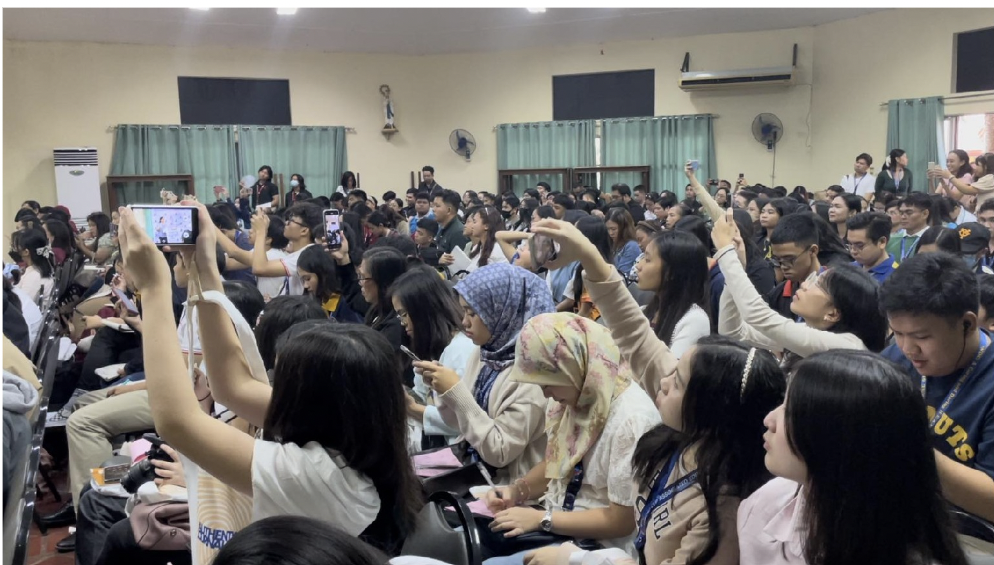Uptrend in science museums investment to benefit DepEd learners

Dr. Eugenio Sonny O. Calapit, executive director of Word Cup Associated Editors Co., welcomes some 250 campus journalists to the 21st Word Cup National Journalism Conference and Contests at Angels Hill, Tagaytay.
MANILA, Philippines–A young campus journalist struggled to free a rope trapped inside a one-meter tall, square-shaped metal device. A puzzle master quickly intervened, demonstrating how to navigate the tubular labyrinth.
This “rope puzzle” was among the many interactive exhibits that captivated the 250 campus journalists and school publication advisers attending the 21st Word Cup National Journalism Conference and Contests held in Tagaytay City on May 4-5.
May Pagsinohin, executive director of the Philippine Science and Technology Foundation (PSTF), explained that science museums like these are designed to pique children’s curiosity and interest in science.
While the PSTF-operated Science Centrum in Marikina remains closed to the public despite the lifting of health restrictions, Pagsinohin acknowledges that investment in science museums in the Philippines falls short compared to ASEAN neighbors.
She admits that the minimum PhP5 million required for Science Centrum to set up regional hubs and conduct traveling exhibitions is low by ASEAN standards. In Singapore, the same amount can only finance 2-3 exhibits, whereas the Philippines can create around 30.
Article continues after this advertisement“That’s the minimum to have the basic set of interactive exhibits,” said Pagsinohin.
Article continues after this advertisementHowever, the Philippines makes up for its lack of funding with resourcefulness. “Our advantage is that we have our own fabrication company and our staff are trained abroad so we can create exhibits at lesser costs,” explains Pagsinohin.
“We have even supplied science museums in the US, Australia, Ireland, Malaysia, Brunei, and Nepal,” Pagsinohin added.
On a brighter note, Pagsinohin observes an “uptrend in science museum investments,” with private companies like Unilab’s STEM+PH, PHILSA, and DOST’s Community Empowerment for S&T (CEST) leading the way.

Dr. Eugenio Sonny O. Calapit, executive director of Word Cup Associated Editors Co., welcomes some 250 campus journalists to the 21st Word Cup National Journalism Conference and Contests at Angels Hill, Tagaytay.
A recent project, the “STEM on the GO Project,” is a collaboration between PSFT, DOST, and the BARMM that aims to reach 50,000 learners in Tawi Tawi, Sulu, Basilan, and Lamitan this August.
Pagsinohin’s co-presenter, Dr. Ruby Roan-Cristobal, head of the Science Communicators Philippines (SciCommPh), urged scientists to be more vocal about science communication.
“NGOs are more vocal,” she pointed out to the campus journalists, “while scientists and researchers are often silent.”
Dr. Cristobal, a senior lecturer at UP Los Banos College of Development Communication and a retired DOST scientist, believes this silence contributes to the low interest in science among students.
She sees campus journalists as “microphones” that can amplify science-related issues and concerns.
Event organizer Eugenio Calapit explained that the 21st Word Cup adopted a science theme to “voluntarily assist the DepEd in improving science and math education.” The Philippines’ consecutive low rankings in PISA for these subjects prompted this initiative.
Calapit, a former journalist and founder of Word Cup, partnered with the late Claro Cortes III, a Pulitzer Prize candidate, to establish Word Cup in 1994. Their mission is to champion authentic journalism among campus journalists by providing media practitioners as trainers and educators.
Word Cup conferences gather data through press conferences, which student journalists can then use for their reports.
